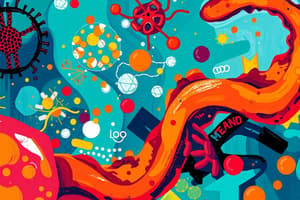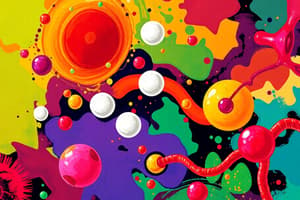Podcast
Questions and Answers
What is the primary organ responsible for the detoxification and metabolism of drugs?
What is the primary organ responsible for the detoxification and metabolism of drugs?
- Liver (correct)
- Kidneys
- Lungs
- Heart
Drug excretion can occur through saliva and breast milk.
Drug excretion can occur through saliva and breast milk.
True (A)
What is the term for the phenomenon whereby a drug is greatly reduced in concentration before it reaches systemic circulation following oral administration?
What is the term for the phenomenon whereby a drug is greatly reduced in concentration before it reaches systemic circulation following oral administration?
First pass effect
The time required for the body to eliminate 50% of the drug is known as __________.
The time required for the body to eliminate 50% of the drug is known as __________.
Match the following terms with their definitions:
Match the following terms with their definitions:
Which route of administration typically has the fastest absorption rate?
Which route of administration typically has the fastest absorption rate?
Drugs that are highly lipid-soluble are slower to be absorbed than those with low lipid solubility.
Drugs that are highly lipid-soluble are slower to be absorbed than those with low lipid solubility.
What is the primary determinant for the rate of drug absorption in the body?
What is the primary determinant for the rate of drug absorption in the body?
The __________ of a drug is influenced by its physical and chemical properties, such as pH and lipid solubility.
The __________ of a drug is influenced by its physical and chemical properties, such as pH and lipid solubility.
Match the drug absorption factors with their descriptions:
Match the drug absorption factors with their descriptions:
Flashcards are hidden until you start studying
Study Notes
Distribution of Drug Molecules
- Involves transporting drugs to target sites in the body.
- Blood circulation is essential for delivering drugs to organs like the heart, liver, and kidneys.
- Drug distribution occurs via movement to tissues and intracellular spaces.
- Key factors in distribution include:
- Protein Binding: Influences drug availability.
- Blood-Brain Barrier: Restricts certain drugs from entering the brain.
- Placental Transfer: Drugs can cross the placenta and enter breast milk.
Metabolism (Biotransformation)
- Refers to the chemical alteration of drug structures in the body.
- Primarily occurs in the liver, where detoxification takes place.
- Cytochrome P450 enzymes play a significant role in metabolizing most drugs into less active forms.
- First Pass Effect: Oral drugs may undergo significant metabolism before reaching systemic circulation, reducing drug concentration.
- Six therapeutic consequences of metabolism include:
- Accelerated renal drug excretion
- Drug inactivation or increased therapeutic action
- Activation of prodrugs
- Changes in toxicity levels
Excretion
- Defined as the removal of drugs and their metabolites from the body.
- Primary organ for excretion is the kidneys; drugs can also exit via urine, bile, sweat, saliva, breast milk, and expired air.
- Half-Life: Time it takes for drug concentration to decrease by half; varies between drugs.
- Important for determining dosing frequency:
- Short half-life requires more frequent dosing.
- Long half-life may require less frequent dosing.
Absorption Factors
- Routes of Administration: Affects drug absorption rate; oral drugs generally absorbed slower than parenteral routes.
- Intravenous (IV): Provides immediate effect, avoiding initial breakdown.
- Intramuscular (IM): Absorbed into circulation from muscle capillaries.
- Factors influencing absorption:
- Physical/Chemical Properties: Determine drug solubility and absorption rate.
- Physiological Factors: Blood flow and surface area at the absorption site enhance absorption rates.
- Lipid Solubility: Highly lipid-soluble drugs cross membranes easily, promoting faster absorption.
- pH Partitioning: Affects the ionization and absorption of drugs.
Pharmacokinetic Considerations
- Onset of action can vary between drugs.
- Half-life is critical for planning dosing schedules.
- Effects may manifest within minutes or take hours, influenced by sites of excretion and metabolism.
Influencing Factors on Drug Response
- Factors include weight, gender, environmental conditions, individual health, and tolerance levels.
Ethical-legal Considerations in Nursing
- Nurses must follow Nurse Practice Acts, cannot prescribe or administer drugs without a healthcare provider's order.
- Ethical values and principles guide nurse conduct and decision-making.
- American Nurses Association Code of Ethics emphasizes:
- Compassion and respect for each patient’s dignity.
- Primary commitment to patients and their rights.
- Authority and accountability in nursing practice for optimal patient care.
Studying That Suits You
Use AI to generate personalized quizzes and flashcards to suit your learning preferences.





